Cognitive Behavioural Therapy (CBT) - PDF
VerifiedAdded on 2021/01/02
|15
|3515
|349
AI Summary
Contribute Materials
Your contribution can guide someone’s learning journey. Share your
documents today.
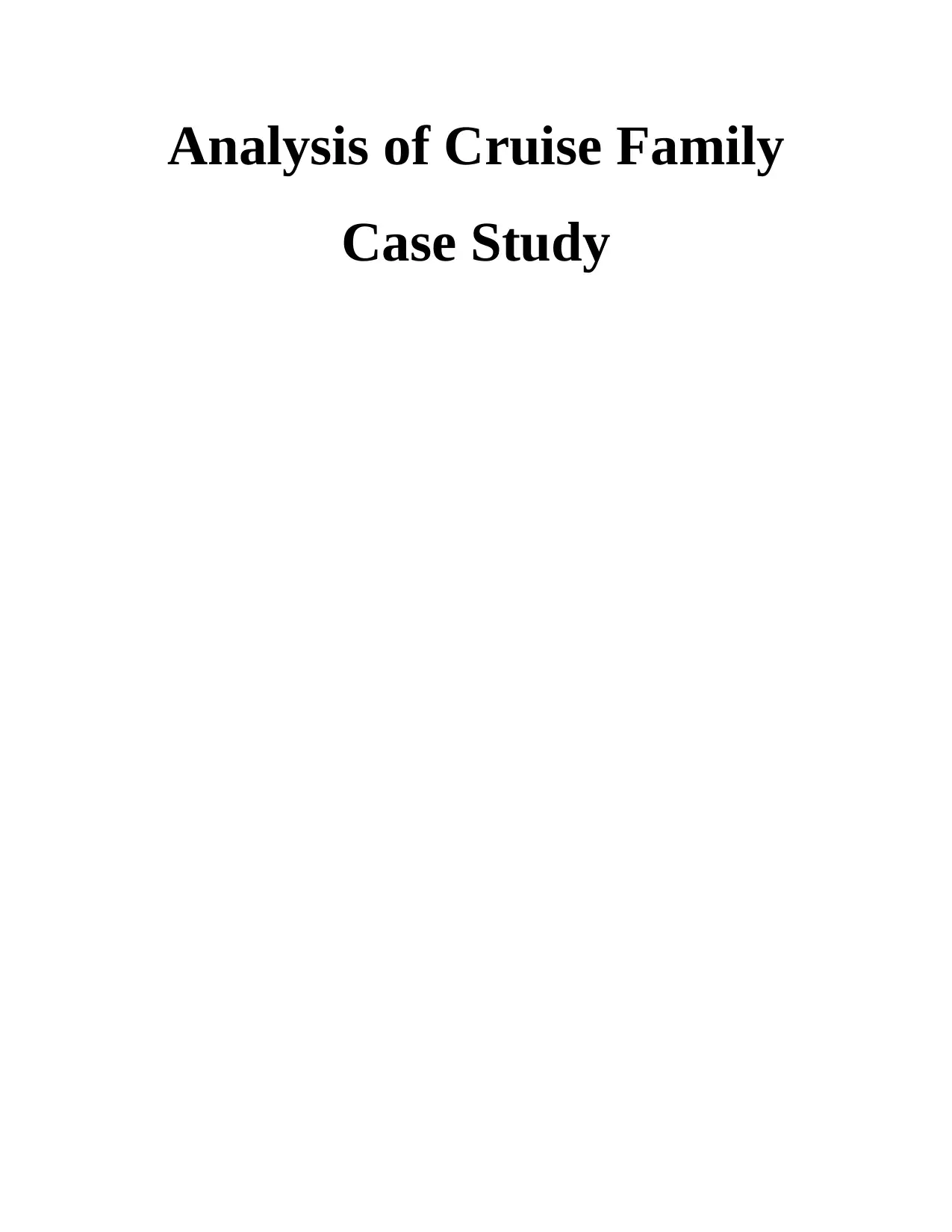
Analysis of Cruise Family
Case Study
Case Study
Secure Best Marks with AI Grader
Need help grading? Try our AI Grader for instant feedback on your assignments.
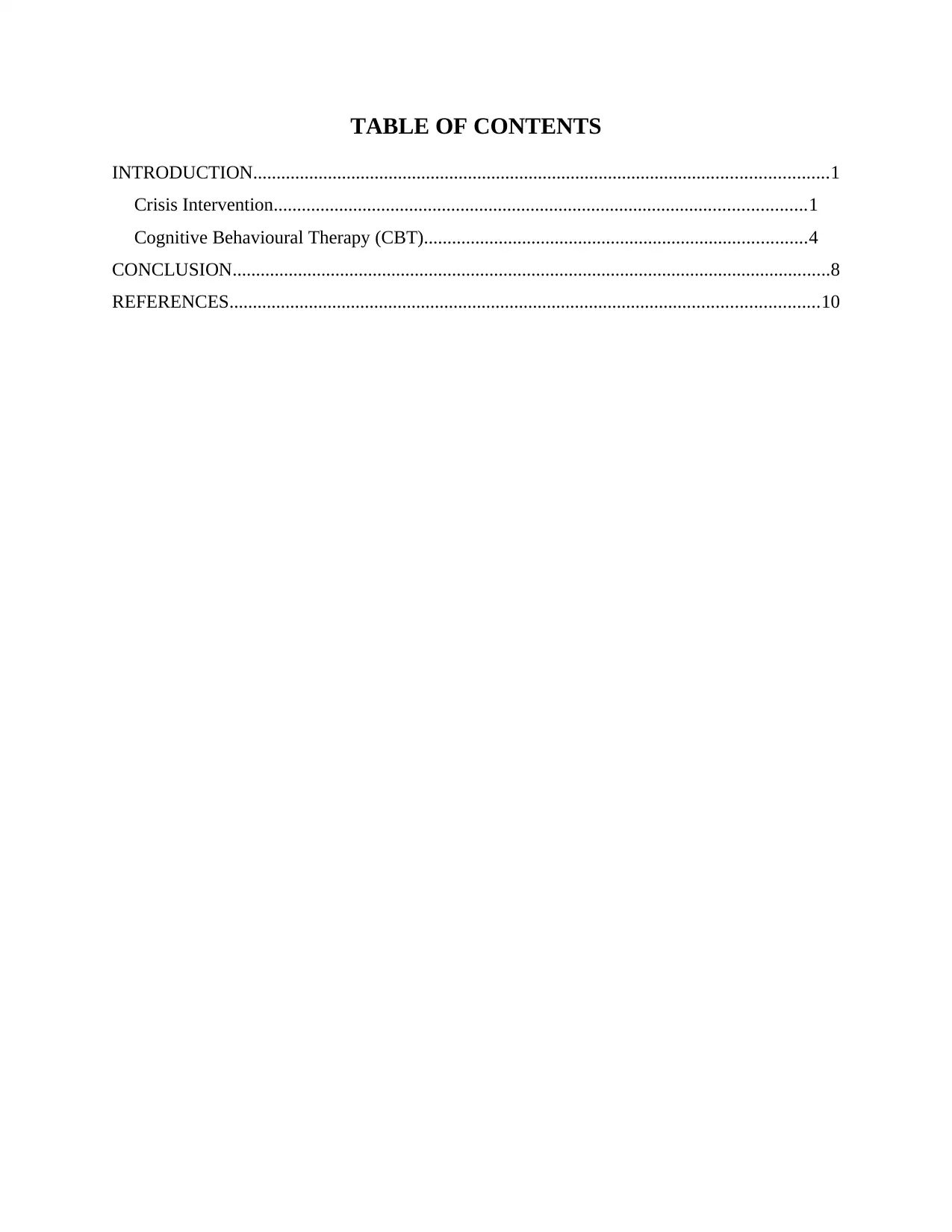
TABLE OF CONTENTS
INTRODUCTION...........................................................................................................................1
Crisis Intervention..................................................................................................................1
Cognitive Behavioural Therapy (CBT)..................................................................................4
CONCLUSION................................................................................................................................8
REFERENCES..............................................................................................................................10
INTRODUCTION...........................................................................................................................1
Crisis Intervention..................................................................................................................1
Cognitive Behavioural Therapy (CBT)..................................................................................4
CONCLUSION................................................................................................................................8
REFERENCES..............................................................................................................................10
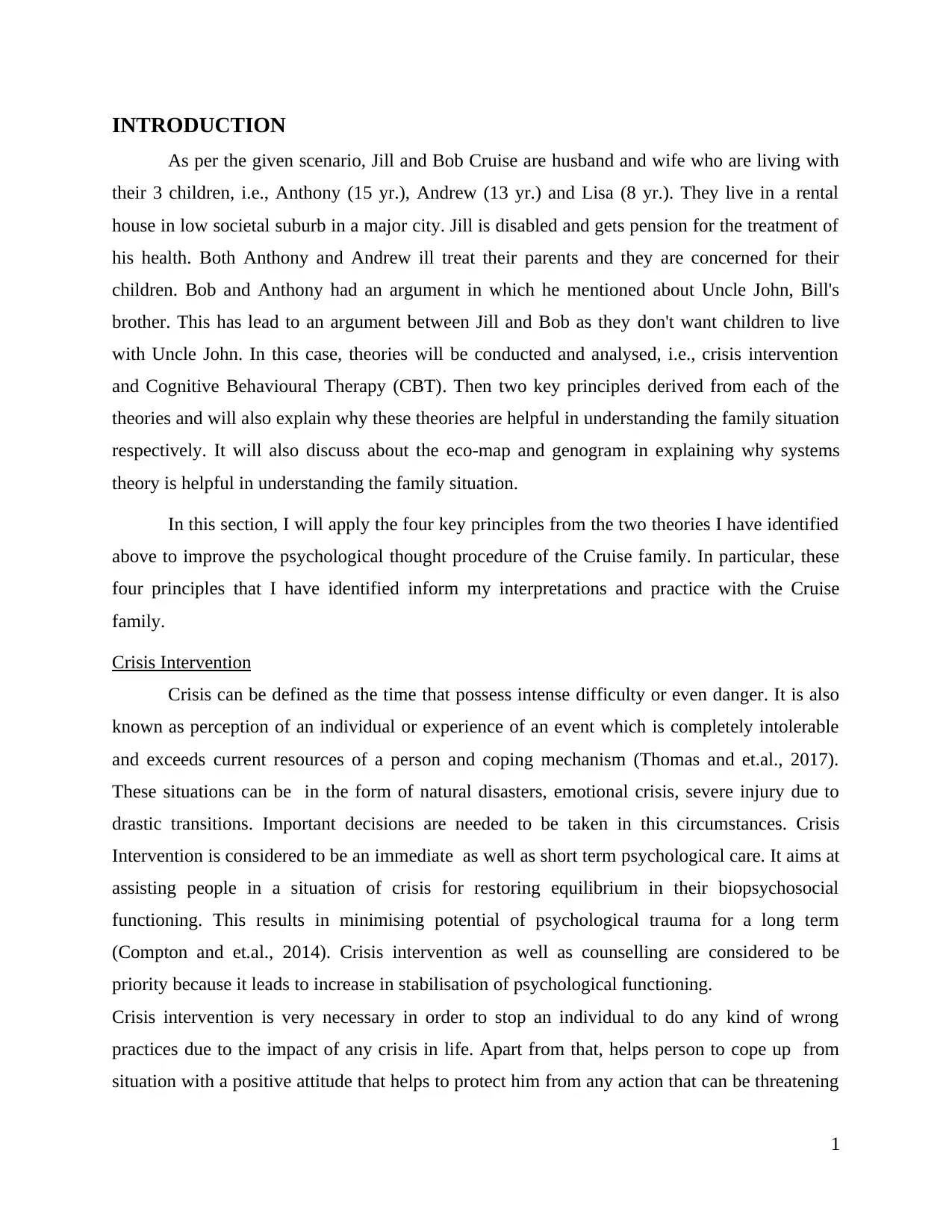
INTRODUCTION
As per the given scenario, Jill and Bob Cruise are husband and wife who are living with
their 3 children, i.e., Anthony (15 yr.), Andrew (13 yr.) and Lisa (8 yr.). They live in a rental
house in low societal suburb in a major city. Jill is disabled and gets pension for the treatment of
his health. Both Anthony and Andrew ill treat their parents and they are concerned for their
children. Bob and Anthony had an argument in which he mentioned about Uncle John, Bill's
brother. This has lead to an argument between Jill and Bob as they don't want children to live
with Uncle John. In this case, theories will be conducted and analysed, i.e., crisis intervention
and Cognitive Behavioural Therapy (CBT). Then two key principles derived from each of the
theories and will also explain why these theories are helpful in understanding the family situation
respectively. It will also discuss about the eco-map and genogram in explaining why systems
theory is helpful in understanding the family situation.
In this section, I will apply the four key principles from the two theories I have identified
above to improve the psychological thought procedure of the Cruise family. In particular, these
four principles that I have identified inform my interpretations and practice with the Cruise
family.
Crisis Intervention
Crisis can be defined as the time that possess intense difficulty or even danger. It is also
known as perception of an individual or experience of an event which is completely intolerable
and exceeds current resources of a person and coping mechanism (Thomas and et.al., 2017).
These situations can be in the form of natural disasters, emotional crisis, severe injury due to
drastic transitions. Important decisions are needed to be taken in this circumstances. Crisis
Intervention is considered to be an immediate as well as short term psychological care. It aims at
assisting people in a situation of crisis for restoring equilibrium in their biopsychosocial
functioning. This results in minimising potential of psychological trauma for a long term
(Compton and et.al., 2014). Crisis intervention as well as counselling are considered to be
priority because it leads to increase in stabilisation of psychological functioning.
Crisis intervention is very necessary in order to stop an individual to do any kind of wrong
practices due to the impact of any crisis in life. Apart from that, helps person to cope up from
situation with a positive attitude that helps to protect him from any action that can be threatening
1
As per the given scenario, Jill and Bob Cruise are husband and wife who are living with
their 3 children, i.e., Anthony (15 yr.), Andrew (13 yr.) and Lisa (8 yr.). They live in a rental
house in low societal suburb in a major city. Jill is disabled and gets pension for the treatment of
his health. Both Anthony and Andrew ill treat their parents and they are concerned for their
children. Bob and Anthony had an argument in which he mentioned about Uncle John, Bill's
brother. This has lead to an argument between Jill and Bob as they don't want children to live
with Uncle John. In this case, theories will be conducted and analysed, i.e., crisis intervention
and Cognitive Behavioural Therapy (CBT). Then two key principles derived from each of the
theories and will also explain why these theories are helpful in understanding the family situation
respectively. It will also discuss about the eco-map and genogram in explaining why systems
theory is helpful in understanding the family situation.
In this section, I will apply the four key principles from the two theories I have identified
above to improve the psychological thought procedure of the Cruise family. In particular, these
four principles that I have identified inform my interpretations and practice with the Cruise
family.
Crisis Intervention
Crisis can be defined as the time that possess intense difficulty or even danger. It is also
known as perception of an individual or experience of an event which is completely intolerable
and exceeds current resources of a person and coping mechanism (Thomas and et.al., 2017).
These situations can be in the form of natural disasters, emotional crisis, severe injury due to
drastic transitions. Important decisions are needed to be taken in this circumstances. Crisis
Intervention is considered to be an immediate as well as short term psychological care. It aims at
assisting people in a situation of crisis for restoring equilibrium in their biopsychosocial
functioning. This results in minimising potential of psychological trauma for a long term
(Compton and et.al., 2014). Crisis intervention as well as counselling are considered to be
priority because it leads to increase in stabilisation of psychological functioning.
Crisis intervention is very necessary in order to stop an individual to do any kind of wrong
practices due to the impact of any crisis in life. Apart from that, helps person to cope up from
situation with a positive attitude that helps to protect him from any action that can be threatening
1
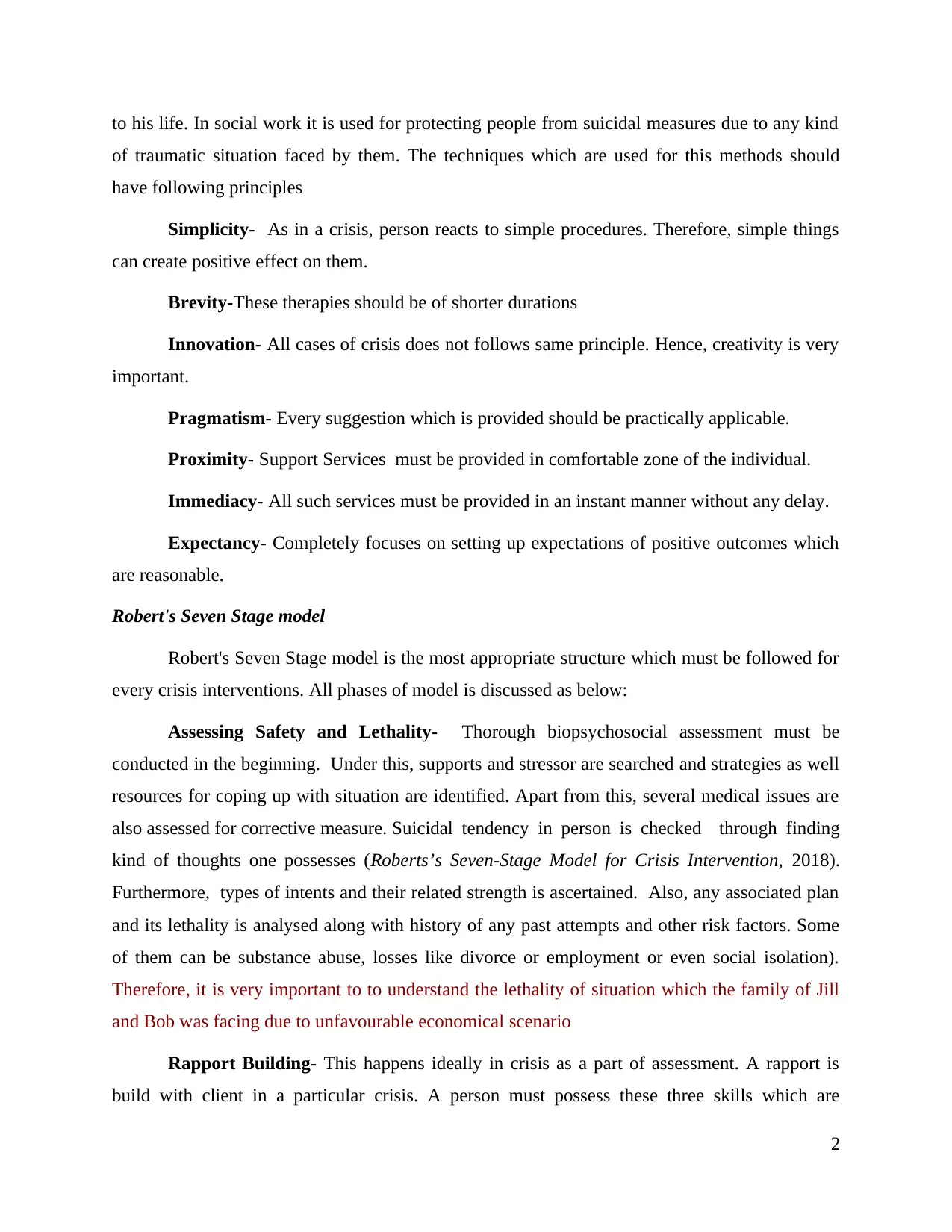
to his life. In social work it is used for protecting people from suicidal measures due to any kind
of traumatic situation faced by them. The techniques which are used for this methods should
have following principles
Simplicity- As in a crisis, person reacts to simple procedures. Therefore, simple things
can create positive effect on them.
Brevity-These therapies should be of shorter durations
Innovation- All cases of crisis does not follows same principle. Hence, creativity is very
important.
Pragmatism- Every suggestion which is provided should be practically applicable.
Proximity- Support Services must be provided in comfortable zone of the individual.
Immediacy- All such services must be provided in an instant manner without any delay.
Expectancy- Completely focuses on setting up expectations of positive outcomes which
are reasonable.
Robert's Seven Stage model
Robert's Seven Stage model is the most appropriate structure which must be followed for
every crisis interventions. All phases of model is discussed as below:
Assessing Safety and Lethality- Thorough biopsychosocial assessment must be
conducted in the beginning. Under this, supports and stressor are searched and strategies as well
resources for coping up with situation are identified. Apart from this, several medical issues are
also assessed for corrective measure. Suicidal tendency in person is checked through finding
kind of thoughts one possesses (Roberts’s Seven-Stage Model for Crisis Intervention, 2018).
Furthermore, types of intents and their related strength is ascertained. Also, any associated plan
and its lethality is analysed along with history of any past attempts and other risk factors. Some
of them can be substance abuse, losses like divorce or employment or even social isolation).
Therefore, it is very important to to understand the lethality of situation which the family of Jill
and Bob was facing due to unfavourable economical scenario
Rapport Building- This happens ideally in crisis as a part of assessment. A rapport is
build with client in a particular crisis. A person must possess these three skills which are
2
of traumatic situation faced by them. The techniques which are used for this methods should
have following principles
Simplicity- As in a crisis, person reacts to simple procedures. Therefore, simple things
can create positive effect on them.
Brevity-These therapies should be of shorter durations
Innovation- All cases of crisis does not follows same principle. Hence, creativity is very
important.
Pragmatism- Every suggestion which is provided should be practically applicable.
Proximity- Support Services must be provided in comfortable zone of the individual.
Immediacy- All such services must be provided in an instant manner without any delay.
Expectancy- Completely focuses on setting up expectations of positive outcomes which
are reasonable.
Robert's Seven Stage model
Robert's Seven Stage model is the most appropriate structure which must be followed for
every crisis interventions. All phases of model is discussed as below:
Assessing Safety and Lethality- Thorough biopsychosocial assessment must be
conducted in the beginning. Under this, supports and stressor are searched and strategies as well
resources for coping up with situation are identified. Apart from this, several medical issues are
also assessed for corrective measure. Suicidal tendency in person is checked through finding
kind of thoughts one possesses (Roberts’s Seven-Stage Model for Crisis Intervention, 2018).
Furthermore, types of intents and their related strength is ascertained. Also, any associated plan
and its lethality is analysed along with history of any past attempts and other risk factors. Some
of them can be substance abuse, losses like divorce or employment or even social isolation).
Therefore, it is very important to to understand the lethality of situation which the family of Jill
and Bob was facing due to unfavourable economical scenario
Rapport Building- This happens ideally in crisis as a part of assessment. A rapport is
build with client in a particular crisis. A person must possess these three skills which are
2
Secure Best Marks with AI Grader
Need help grading? Try our AI Grader for instant feedback on your assignments.
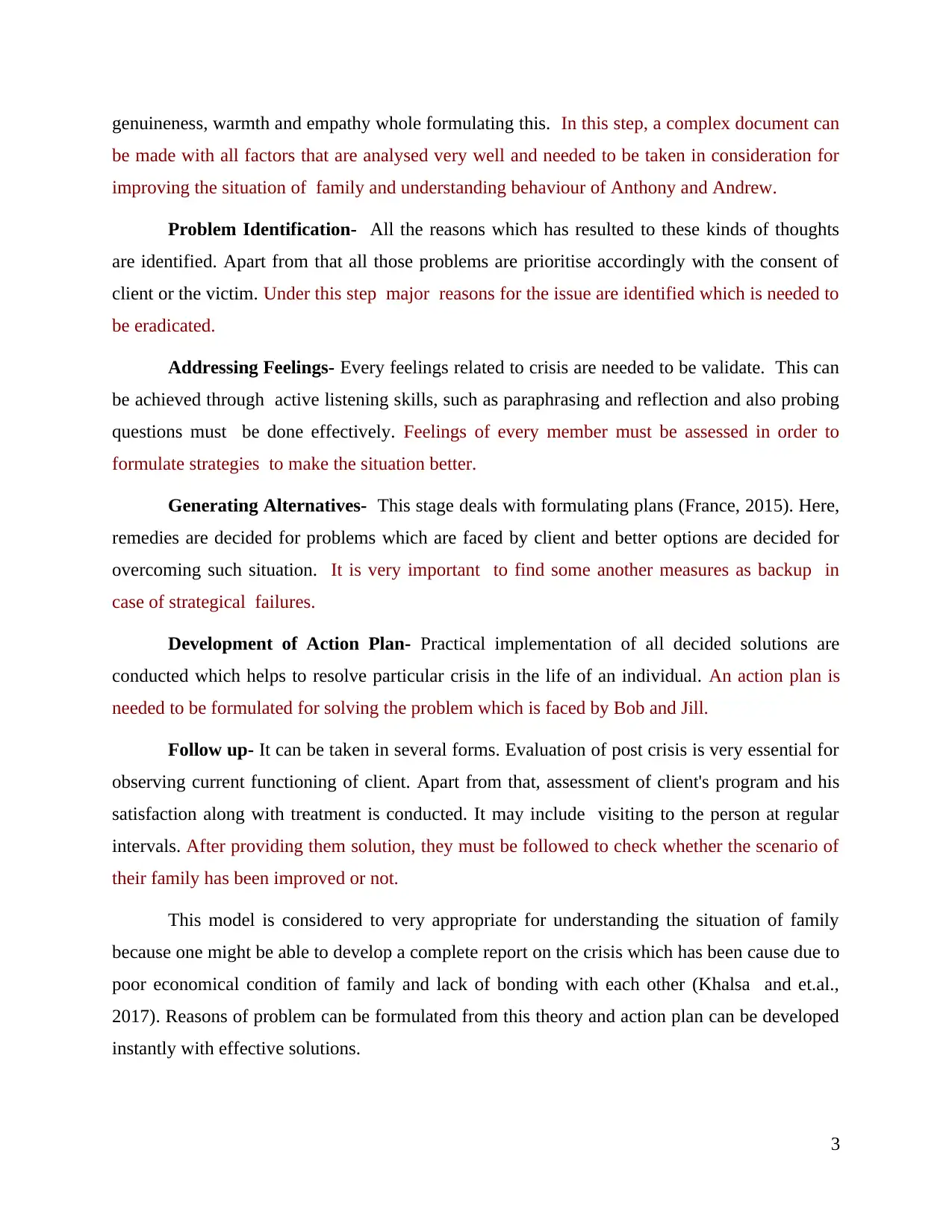
genuineness, warmth and empathy whole formulating this. In this step, a complex document can
be made with all factors that are analysed very well and needed to be taken in consideration for
improving the situation of family and understanding behaviour of Anthony and Andrew.
Problem Identification- All the reasons which has resulted to these kinds of thoughts
are identified. Apart from that all those problems are prioritise accordingly with the consent of
client or the victim. Under this step major reasons for the issue are identified which is needed to
be eradicated.
Addressing Feelings- Every feelings related to crisis are needed to be validate. This can
be achieved through active listening skills, such as paraphrasing and reflection and also probing
questions must be done effectively. Feelings of every member must be assessed in order to
formulate strategies to make the situation better.
Generating Alternatives- This stage deals with formulating plans (France, 2015). Here,
remedies are decided for problems which are faced by client and better options are decided for
overcoming such situation. It is very important to find some another measures as backup in
case of strategical failures.
Development of Action Plan- Practical implementation of all decided solutions are
conducted which helps to resolve particular crisis in the life of an individual. An action plan is
needed to be formulated for solving the problem which is faced by Bob and Jill.
Follow up- It can be taken in several forms. Evaluation of post crisis is very essential for
observing current functioning of client. Apart from that, assessment of client's program and his
satisfaction along with treatment is conducted. It may include visiting to the person at regular
intervals. After providing them solution, they must be followed to check whether the scenario of
their family has been improved or not.
This model is considered to very appropriate for understanding the situation of family
because one might be able to develop a complete report on the crisis which has been cause due to
poor economical condition of family and lack of bonding with each other (Khalsa and et.al.,
2017). Reasons of problem can be formulated from this theory and action plan can be developed
instantly with effective solutions.
3
be made with all factors that are analysed very well and needed to be taken in consideration for
improving the situation of family and understanding behaviour of Anthony and Andrew.
Problem Identification- All the reasons which has resulted to these kinds of thoughts
are identified. Apart from that all those problems are prioritise accordingly with the consent of
client or the victim. Under this step major reasons for the issue are identified which is needed to
be eradicated.
Addressing Feelings- Every feelings related to crisis are needed to be validate. This can
be achieved through active listening skills, such as paraphrasing and reflection and also probing
questions must be done effectively. Feelings of every member must be assessed in order to
formulate strategies to make the situation better.
Generating Alternatives- This stage deals with formulating plans (France, 2015). Here,
remedies are decided for problems which are faced by client and better options are decided for
overcoming such situation. It is very important to find some another measures as backup in
case of strategical failures.
Development of Action Plan- Practical implementation of all decided solutions are
conducted which helps to resolve particular crisis in the life of an individual. An action plan is
needed to be formulated for solving the problem which is faced by Bob and Jill.
Follow up- It can be taken in several forms. Evaluation of post crisis is very essential for
observing current functioning of client. Apart from that, assessment of client's program and his
satisfaction along with treatment is conducted. It may include visiting to the person at regular
intervals. After providing them solution, they must be followed to check whether the scenario of
their family has been improved or not.
This model is considered to very appropriate for understanding the situation of family
because one might be able to develop a complete report on the crisis which has been cause due to
poor economical condition of family and lack of bonding with each other (Khalsa and et.al.,
2017). Reasons of problem can be formulated from this theory and action plan can be developed
instantly with effective solutions.
3
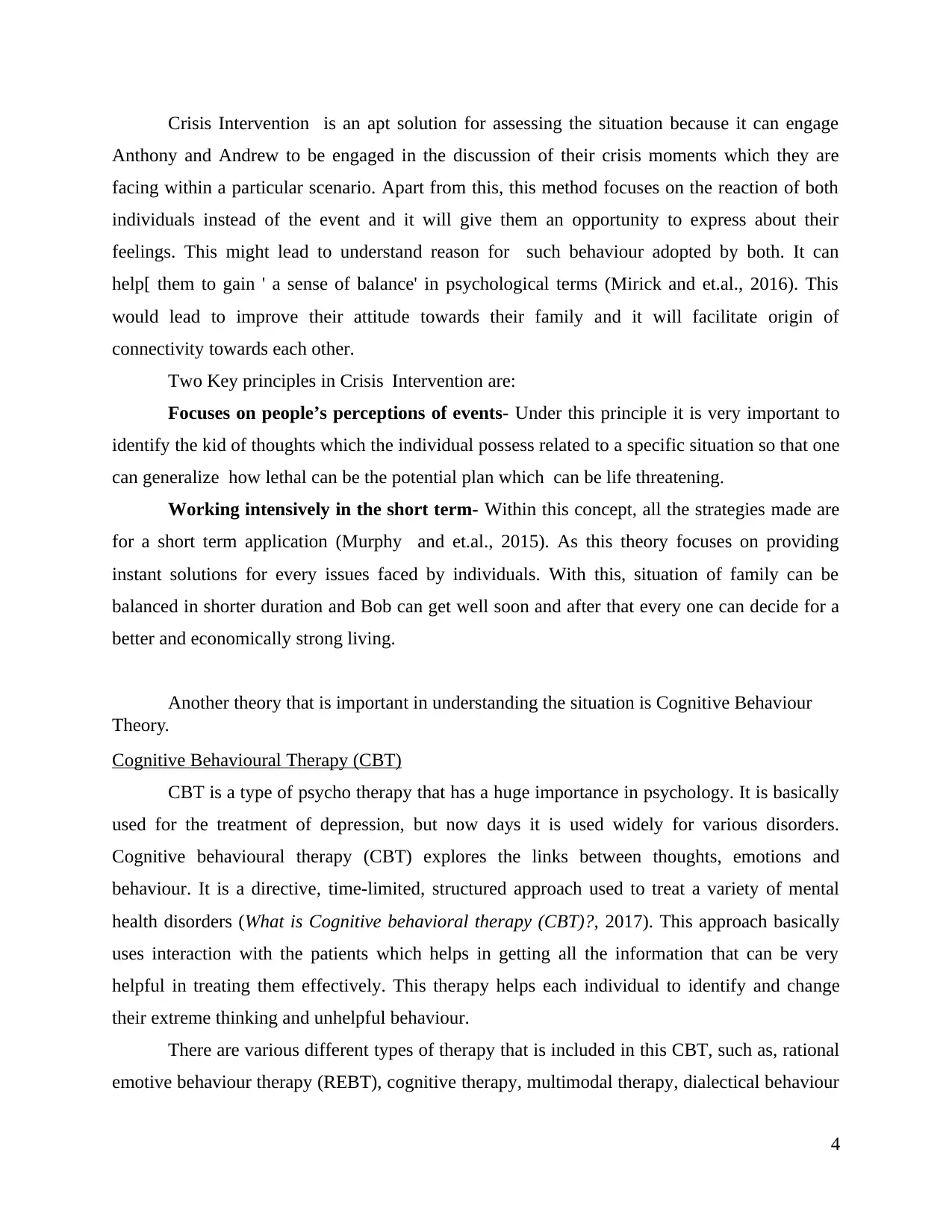
Crisis Intervention is an apt solution for assessing the situation because it can engage
Anthony and Andrew to be engaged in the discussion of their crisis moments which they are
facing within a particular scenario. Apart from this, this method focuses on the reaction of both
individuals instead of the event and it will give them an opportunity to express about their
feelings. This might lead to understand reason for such behaviour adopted by both. It can
help[ them to gain ' a sense of balance' in psychological terms (Mirick and et.al., 2016). This
would lead to improve their attitude towards their family and it will facilitate origin of
connectivity towards each other.
Two Key principles in Crisis Intervention are:
Focuses on people’s perceptions of events- Under this principle it is very important to
identify the kid of thoughts which the individual possess related to a specific situation so that one
can generalize how lethal can be the potential plan which can be life threatening.
Working intensively in the short term- Within this concept, all the strategies made are
for a short term application (Murphy and et.al., 2015). As this theory focuses on providing
instant solutions for every issues faced by individuals. With this, situation of family can be
balanced in shorter duration and Bob can get well soon and after that every one can decide for a
better and economically strong living.
Another theory that is important in understanding the situation is Cognitive Behaviour
Theory.
Cognitive Behavioural Therapy (CBT)
CBT is a type of psycho therapy that has a huge importance in psychology. It is basically
used for the treatment of depression, but now days it is used widely for various disorders.
Cognitive behavioural therapy (CBT) explores the links between thoughts, emotions and
behaviour. It is a directive, time-limited, structured approach used to treat a variety of mental
health disorders (What is Cognitive behavioral therapy (CBT)?, 2017). This approach basically
uses interaction with the patients which helps in getting all the information that can be very
helpful in treating them effectively. This therapy helps each individual to identify and change
their extreme thinking and unhelpful behaviour.
There are various different types of therapy that is included in this CBT, such as, rational
emotive behaviour therapy (REBT), cognitive therapy, multimodal therapy, dialectical behaviour
4
Anthony and Andrew to be engaged in the discussion of their crisis moments which they are
facing within a particular scenario. Apart from this, this method focuses on the reaction of both
individuals instead of the event and it will give them an opportunity to express about their
feelings. This might lead to understand reason for such behaviour adopted by both. It can
help[ them to gain ' a sense of balance' in psychological terms (Mirick and et.al., 2016). This
would lead to improve their attitude towards their family and it will facilitate origin of
connectivity towards each other.
Two Key principles in Crisis Intervention are:
Focuses on people’s perceptions of events- Under this principle it is very important to
identify the kid of thoughts which the individual possess related to a specific situation so that one
can generalize how lethal can be the potential plan which can be life threatening.
Working intensively in the short term- Within this concept, all the strategies made are
for a short term application (Murphy and et.al., 2015). As this theory focuses on providing
instant solutions for every issues faced by individuals. With this, situation of family can be
balanced in shorter duration and Bob can get well soon and after that every one can decide for a
better and economically strong living.
Another theory that is important in understanding the situation is Cognitive Behaviour
Theory.
Cognitive Behavioural Therapy (CBT)
CBT is a type of psycho therapy that has a huge importance in psychology. It is basically
used for the treatment of depression, but now days it is used widely for various disorders.
Cognitive behavioural therapy (CBT) explores the links between thoughts, emotions and
behaviour. It is a directive, time-limited, structured approach used to treat a variety of mental
health disorders (What is Cognitive behavioral therapy (CBT)?, 2017). This approach basically
uses interaction with the patients which helps in getting all the information that can be very
helpful in treating them effectively. This therapy helps each individual to identify and change
their extreme thinking and unhelpful behaviour.
There are various different types of therapy that is included in this CBT, such as, rational
emotive behaviour therapy (REBT), cognitive therapy, multimodal therapy, dialectical behaviour
4
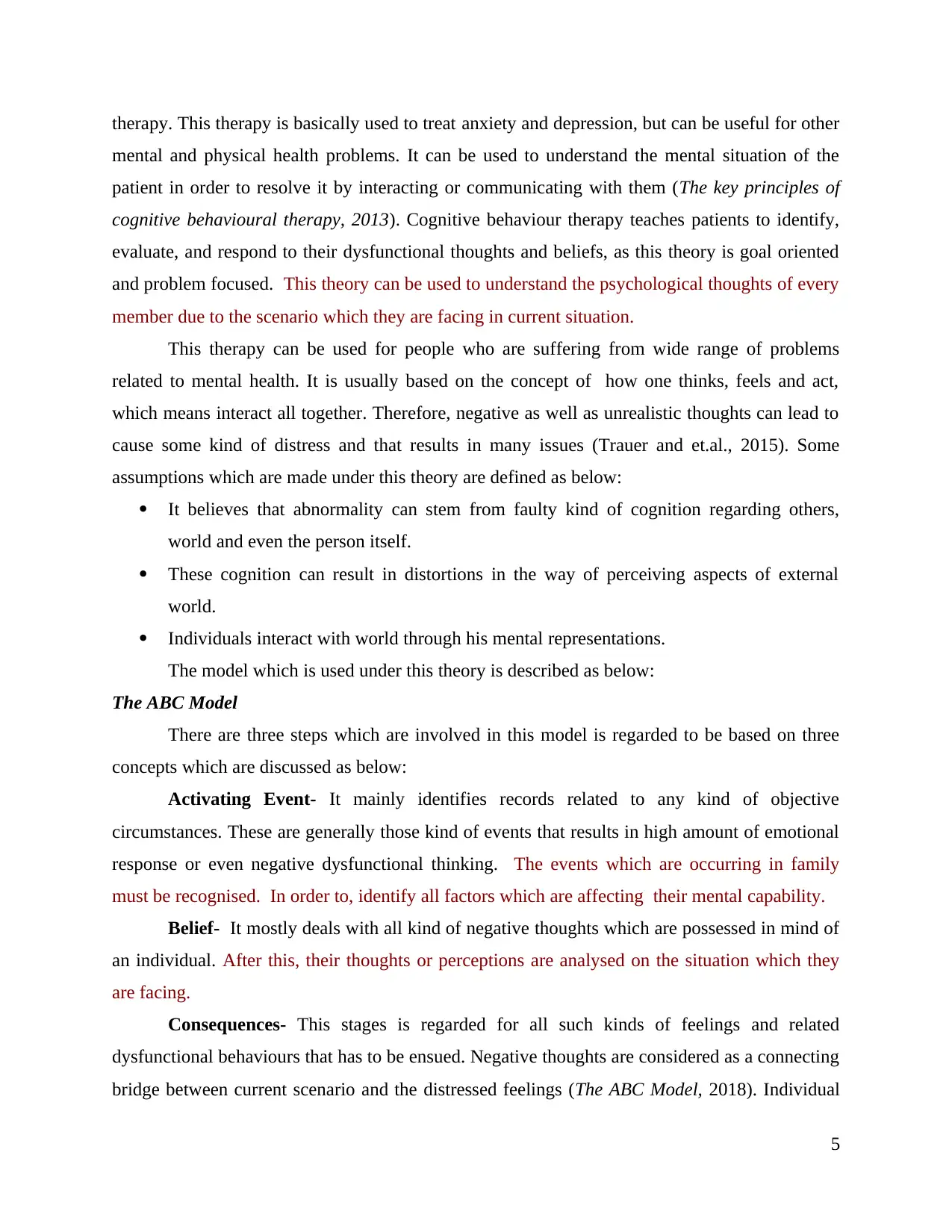
therapy. This therapy is basically used to treat anxiety and depression, but can be useful for other
mental and physical health problems. It can be used to understand the mental situation of the
patient in order to resolve it by interacting or communicating with them (The key principles of
cognitive behavioural therapy, 2013). Cognitive behaviour therapy teaches patients to identify,
evaluate, and respond to their dysfunctional thoughts and beliefs, as this theory is goal oriented
and problem focused. This theory can be used to understand the psychological thoughts of every
member due to the scenario which they are facing in current situation.
This therapy can be used for people who are suffering from wide range of problems
related to mental health. It is usually based on the concept of how one thinks, feels and act,
which means interact all together. Therefore, negative as well as unrealistic thoughts can lead to
cause some kind of distress and that results in many issues (Trauer and et.al., 2015). Some
assumptions which are made under this theory are defined as below:
It believes that abnormality can stem from faulty kind of cognition regarding others,
world and even the person itself.
These cognition can result in distortions in the way of perceiving aspects of external
world.
Individuals interact with world through his mental representations.
The model which is used under this theory is described as below:
The ABC Model
There are three steps which are involved in this model is regarded to be based on three
concepts which are discussed as below:
Activating Event- It mainly identifies records related to any kind of objective
circumstances. These are generally those kind of events that results in high amount of emotional
response or even negative dysfunctional thinking. The events which are occurring in family
must be recognised. In order to, identify all factors which are affecting their mental capability.
Belief- It mostly deals with all kind of negative thoughts which are possessed in mind of
an individual. After this, their thoughts or perceptions are analysed on the situation which they
are facing.
Consequences- This stages is regarded for all such kinds of feelings and related
dysfunctional behaviours that has to be ensued. Negative thoughts are considered as a connecting
bridge between current scenario and the distressed feelings (The ABC Model, 2018). Individual
5
mental and physical health problems. It can be used to understand the mental situation of the
patient in order to resolve it by interacting or communicating with them (The key principles of
cognitive behavioural therapy, 2013). Cognitive behaviour therapy teaches patients to identify,
evaluate, and respond to their dysfunctional thoughts and beliefs, as this theory is goal oriented
and problem focused. This theory can be used to understand the psychological thoughts of every
member due to the scenario which they are facing in current situation.
This therapy can be used for people who are suffering from wide range of problems
related to mental health. It is usually based on the concept of how one thinks, feels and act,
which means interact all together. Therefore, negative as well as unrealistic thoughts can lead to
cause some kind of distress and that results in many issues (Trauer and et.al., 2015). Some
assumptions which are made under this theory are defined as below:
It believes that abnormality can stem from faulty kind of cognition regarding others,
world and even the person itself.
These cognition can result in distortions in the way of perceiving aspects of external
world.
Individuals interact with world through his mental representations.
The model which is used under this theory is described as below:
The ABC Model
There are three steps which are involved in this model is regarded to be based on three
concepts which are discussed as below:
Activating Event- It mainly identifies records related to any kind of objective
circumstances. These are generally those kind of events that results in high amount of emotional
response or even negative dysfunctional thinking. The events which are occurring in family
must be recognised. In order to, identify all factors which are affecting their mental capability.
Belief- It mostly deals with all kind of negative thoughts which are possessed in mind of
an individual. After this, their thoughts or perceptions are analysed on the situation which they
are facing.
Consequences- This stages is regarded for all such kinds of feelings and related
dysfunctional behaviours that has to be ensued. Negative thoughts are considered as a connecting
bridge between current scenario and the distressed feelings (The ABC Model, 2018). Individual
5
Paraphrase This Document
Need a fresh take? Get an instant paraphrase of this document with our AI Paraphraser
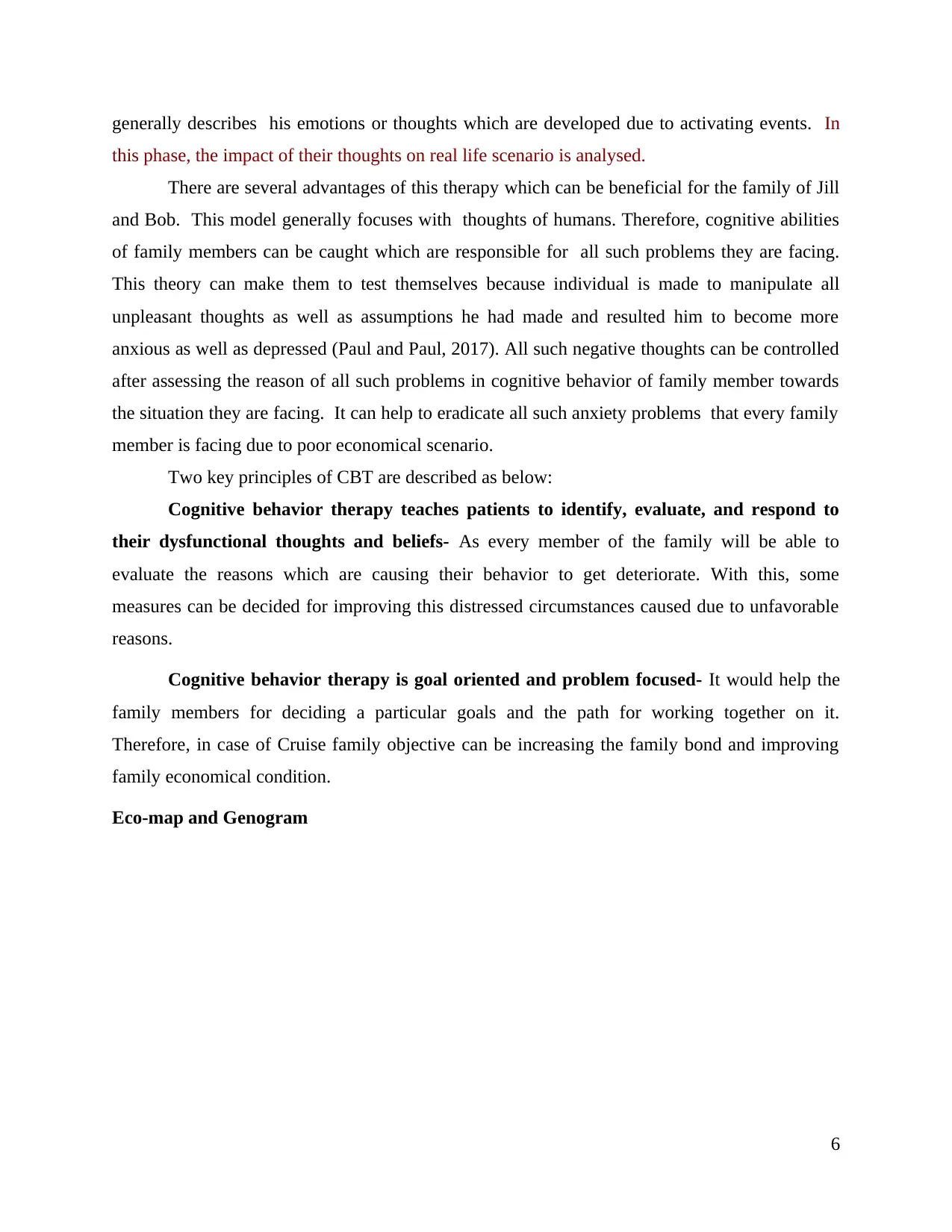
generally describes his emotions or thoughts which are developed due to activating events. In
this phase, the impact of their thoughts on real life scenario is analysed.
There are several advantages of this therapy which can be beneficial for the family of Jill
and Bob. This model generally focuses with thoughts of humans. Therefore, cognitive abilities
of family members can be caught which are responsible for all such problems they are facing.
This theory can make them to test themselves because individual is made to manipulate all
unpleasant thoughts as well as assumptions he had made and resulted him to become more
anxious as well as depressed (Paul and Paul, 2017). All such negative thoughts can be controlled
after assessing the reason of all such problems in cognitive behavior of family member towards
the situation they are facing. It can help to eradicate all such anxiety problems that every family
member is facing due to poor economical scenario.
Two key principles of CBT are described as below:
Cognitive behavior therapy teaches patients to identify, evaluate, and respond to
their dysfunctional thoughts and beliefs- As every member of the family will be able to
evaluate the reasons which are causing their behavior to get deteriorate. With this, some
measures can be decided for improving this distressed circumstances caused due to unfavorable
reasons.
Cognitive behavior therapy is goal oriented and problem focused- It would help the
family members for deciding a particular goals and the path for working together on it.
Therefore, in case of Cruise family objective can be increasing the family bond and improving
family economical condition.
Eco-map and Genogram
6
this phase, the impact of their thoughts on real life scenario is analysed.
There are several advantages of this therapy which can be beneficial for the family of Jill
and Bob. This model generally focuses with thoughts of humans. Therefore, cognitive abilities
of family members can be caught which are responsible for all such problems they are facing.
This theory can make them to test themselves because individual is made to manipulate all
unpleasant thoughts as well as assumptions he had made and resulted him to become more
anxious as well as depressed (Paul and Paul, 2017). All such negative thoughts can be controlled
after assessing the reason of all such problems in cognitive behavior of family member towards
the situation they are facing. It can help to eradicate all such anxiety problems that every family
member is facing due to poor economical scenario.
Two key principles of CBT are described as below:
Cognitive behavior therapy teaches patients to identify, evaluate, and respond to
their dysfunctional thoughts and beliefs- As every member of the family will be able to
evaluate the reasons which are causing their behavior to get deteriorate. With this, some
measures can be decided for improving this distressed circumstances caused due to unfavorable
reasons.
Cognitive behavior therapy is goal oriented and problem focused- It would help the
family members for deciding a particular goals and the path for working together on it.
Therefore, in case of Cruise family objective can be increasing the family bond and improving
family economical condition.
Eco-map and Genogram
6
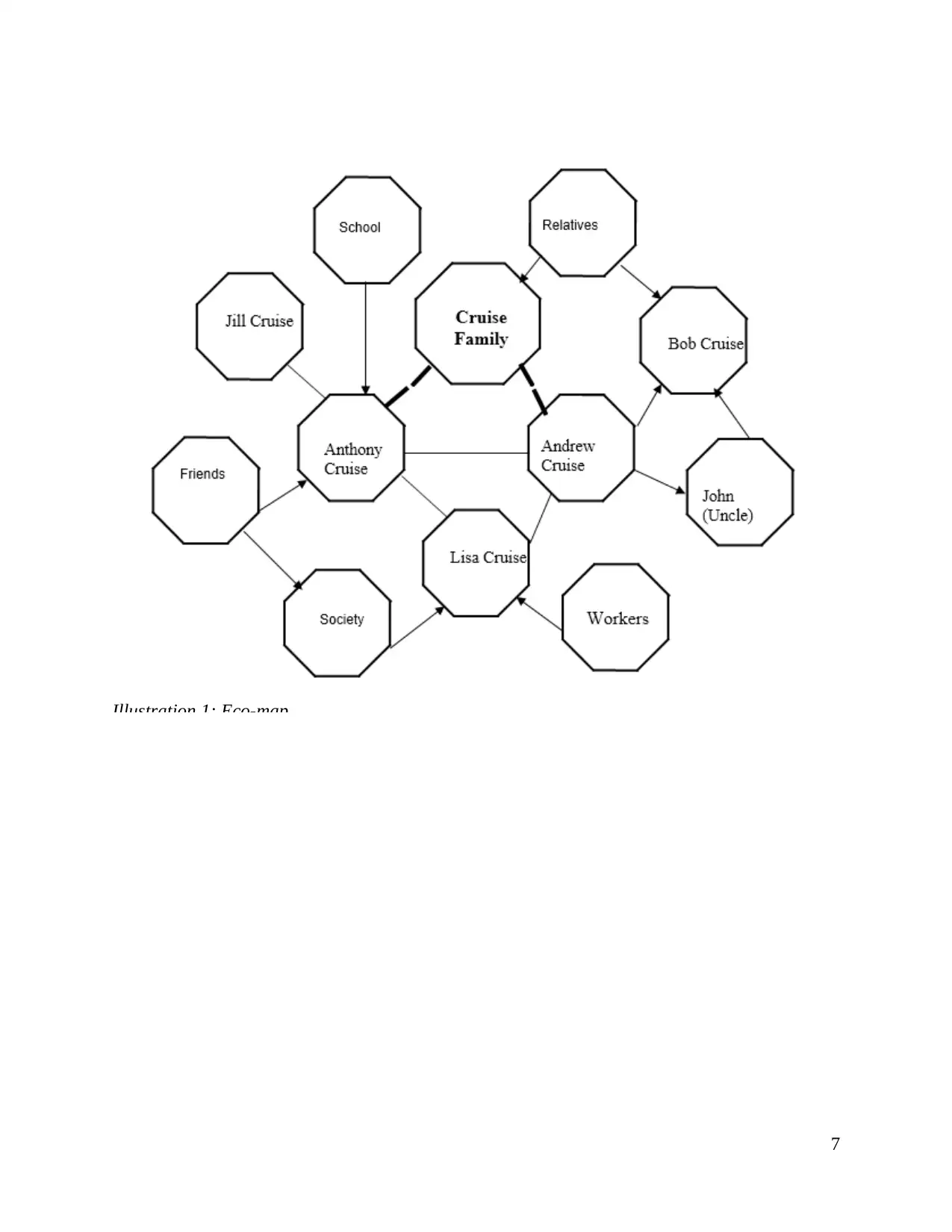
7
Illustration 1: Eco-map
Illustration 1: Eco-map
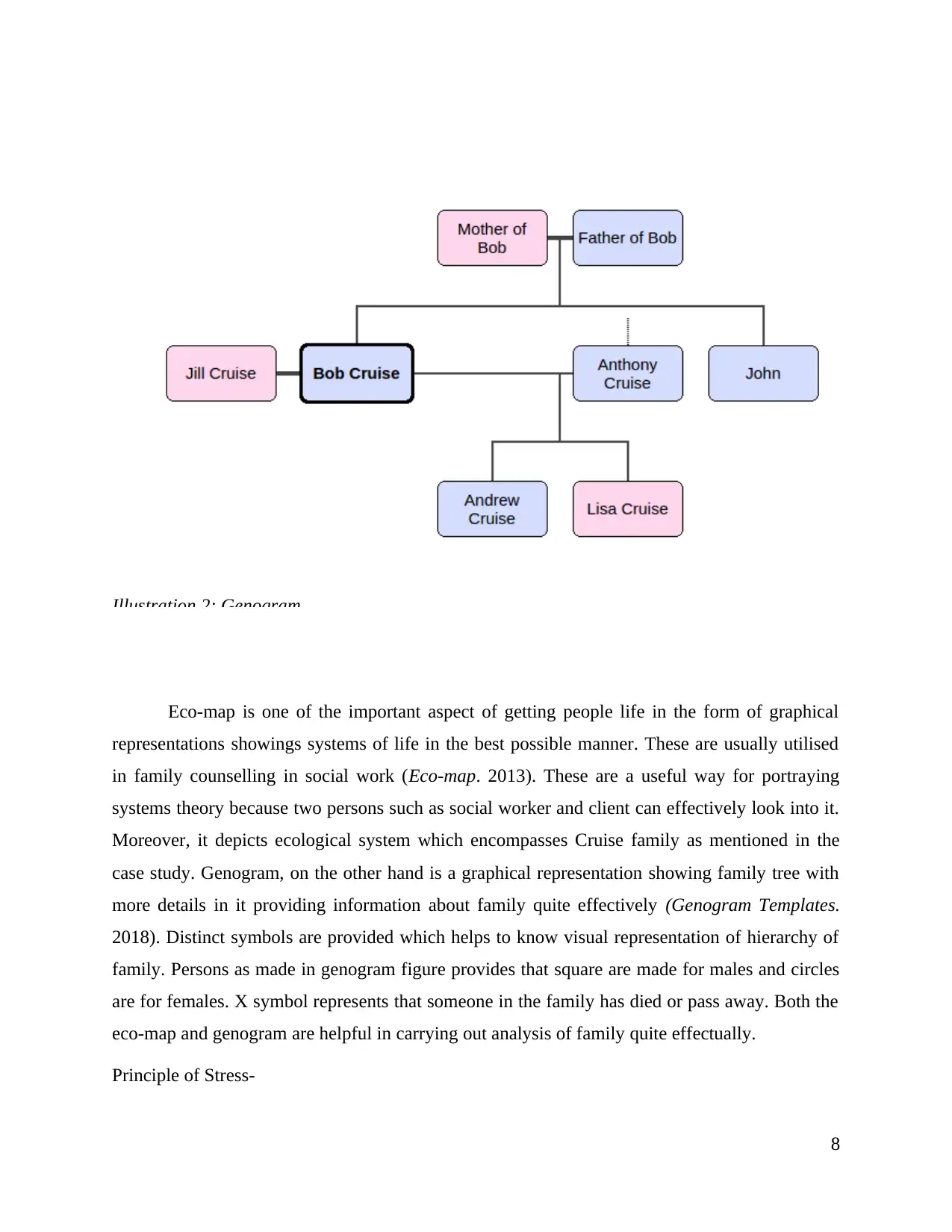
Eco-map is one of the important aspect of getting people life in the form of graphical
representations showings systems of life in the best possible manner. These are usually utilised
in family counselling in social work (Eco-map. 2013). These are a useful way for portraying
systems theory because two persons such as social worker and client can effectively look into it.
Moreover, it depicts ecological system which encompasses Cruise family as mentioned in the
case study. Genogram, on the other hand is a graphical representation showing family tree with
more details in it providing information about family quite effectively (Genogram Templates.
2018). Distinct symbols are provided which helps to know visual representation of hierarchy of
family. Persons as made in genogram figure provides that square are made for males and circles
are for females. X symbol represents that someone in the family has died or pass away. Both the
eco-map and genogram are helpful in carrying out analysis of family quite effectually.
Principle of Stress-
8
Illustration 2: Genogram
representations showings systems of life in the best possible manner. These are usually utilised
in family counselling in social work (Eco-map. 2013). These are a useful way for portraying
systems theory because two persons such as social worker and client can effectively look into it.
Moreover, it depicts ecological system which encompasses Cruise family as mentioned in the
case study. Genogram, on the other hand is a graphical representation showing family tree with
more details in it providing information about family quite effectively (Genogram Templates.
2018). Distinct symbols are provided which helps to know visual representation of hierarchy of
family. Persons as made in genogram figure provides that square are made for males and circles
are for females. X symbol represents that someone in the family has died or pass away. Both the
eco-map and genogram are helpful in carrying out analysis of family quite effectually.
Principle of Stress-
8
Illustration 2: Genogram
Secure Best Marks with AI Grader
Need help grading? Try our AI Grader for instant feedback on your assignments.
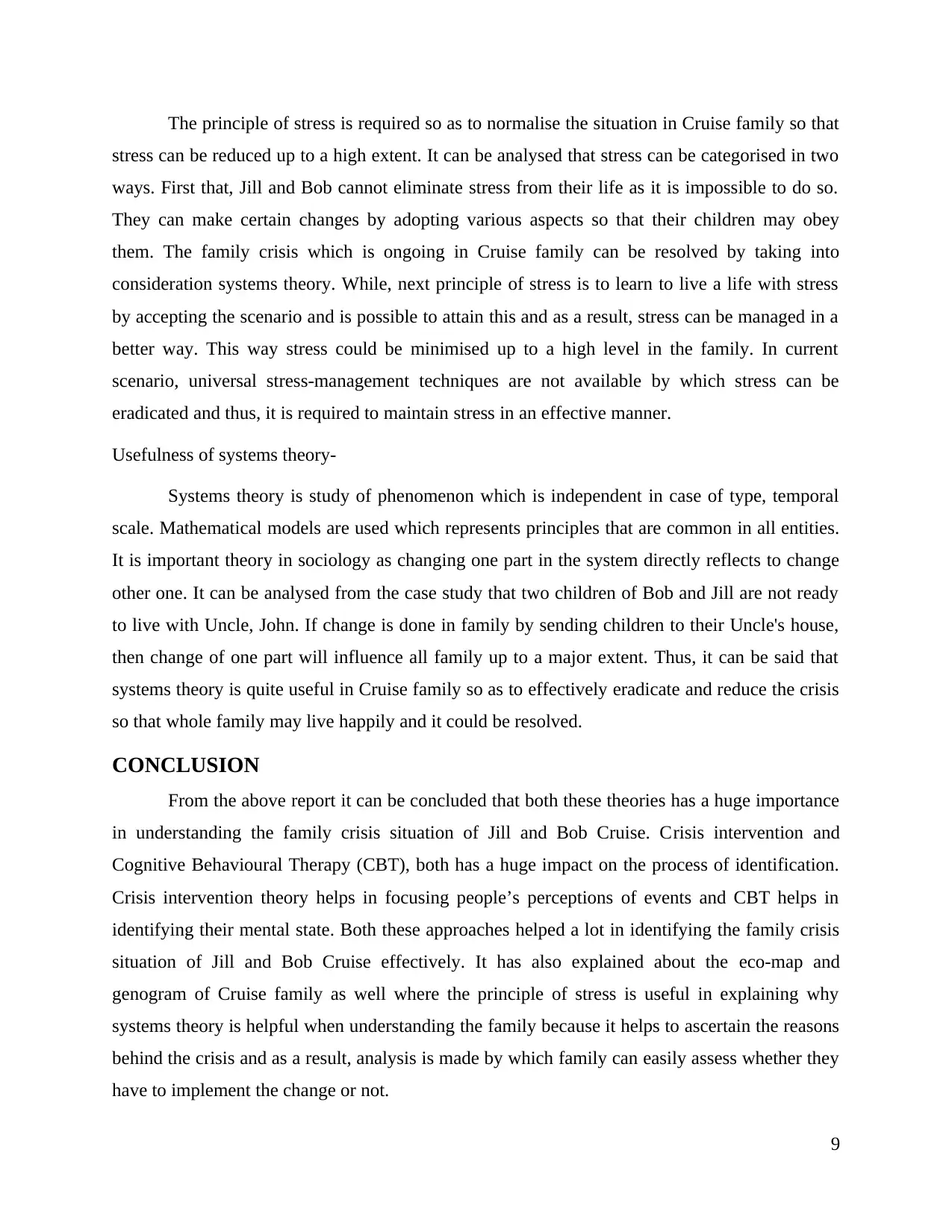
The principle of stress is required so as to normalise the situation in Cruise family so that
stress can be reduced up to a high extent. It can be analysed that stress can be categorised in two
ways. First that, Jill and Bob cannot eliminate stress from their life as it is impossible to do so.
They can make certain changes by adopting various aspects so that their children may obey
them. The family crisis which is ongoing in Cruise family can be resolved by taking into
consideration systems theory. While, next principle of stress is to learn to live a life with stress
by accepting the scenario and is possible to attain this and as a result, stress can be managed in a
better way. This way stress could be minimised up to a high level in the family. In current
scenario, universal stress-management techniques are not available by which stress can be
eradicated and thus, it is required to maintain stress in an effective manner.
Usefulness of systems theory-
Systems theory is study of phenomenon which is independent in case of type, temporal
scale. Mathematical models are used which represents principles that are common in all entities.
It is important theory in sociology as changing one part in the system directly reflects to change
other one. It can be analysed from the case study that two children of Bob and Jill are not ready
to live with Uncle, John. If change is done in family by sending children to their Uncle's house,
then change of one part will influence all family up to a major extent. Thus, it can be said that
systems theory is quite useful in Cruise family so as to effectively eradicate and reduce the crisis
so that whole family may live happily and it could be resolved.
CONCLUSION
From the above report it can be concluded that both these theories has a huge importance
in understanding the family crisis situation of Jill and Bob Cruise. Crisis intervention and
Cognitive Behavioural Therapy (CBT), both has a huge impact on the process of identification.
Crisis intervention theory helps in focusing people’s perceptions of events and CBT helps in
identifying their mental state. Both these approaches helped a lot in identifying the family crisis
situation of Jill and Bob Cruise effectively. It has also explained about the eco-map and
genogram of Cruise family as well where the principle of stress is useful in explaining why
systems theory is helpful when understanding the family because it helps to ascertain the reasons
behind the crisis and as a result, analysis is made by which family can easily assess whether they
have to implement the change or not.
9
stress can be reduced up to a high extent. It can be analysed that stress can be categorised in two
ways. First that, Jill and Bob cannot eliminate stress from their life as it is impossible to do so.
They can make certain changes by adopting various aspects so that their children may obey
them. The family crisis which is ongoing in Cruise family can be resolved by taking into
consideration systems theory. While, next principle of stress is to learn to live a life with stress
by accepting the scenario and is possible to attain this and as a result, stress can be managed in a
better way. This way stress could be minimised up to a high level in the family. In current
scenario, universal stress-management techniques are not available by which stress can be
eradicated and thus, it is required to maintain stress in an effective manner.
Usefulness of systems theory-
Systems theory is study of phenomenon which is independent in case of type, temporal
scale. Mathematical models are used which represents principles that are common in all entities.
It is important theory in sociology as changing one part in the system directly reflects to change
other one. It can be analysed from the case study that two children of Bob and Jill are not ready
to live with Uncle, John. If change is done in family by sending children to their Uncle's house,
then change of one part will influence all family up to a major extent. Thus, it can be said that
systems theory is quite useful in Cruise family so as to effectively eradicate and reduce the crisis
so that whole family may live happily and it could be resolved.
CONCLUSION
From the above report it can be concluded that both these theories has a huge importance
in understanding the family crisis situation of Jill and Bob Cruise. Crisis intervention and
Cognitive Behavioural Therapy (CBT), both has a huge impact on the process of identification.
Crisis intervention theory helps in focusing people’s perceptions of events and CBT helps in
identifying their mental state. Both these approaches helped a lot in identifying the family crisis
situation of Jill and Bob Cruise effectively. It has also explained about the eco-map and
genogram of Cruise family as well where the principle of stress is useful in explaining why
systems theory is helpful when understanding the family because it helps to ascertain the reasons
behind the crisis and as a result, analysis is made by which family can easily assess whether they
have to implement the change or not.
9

10
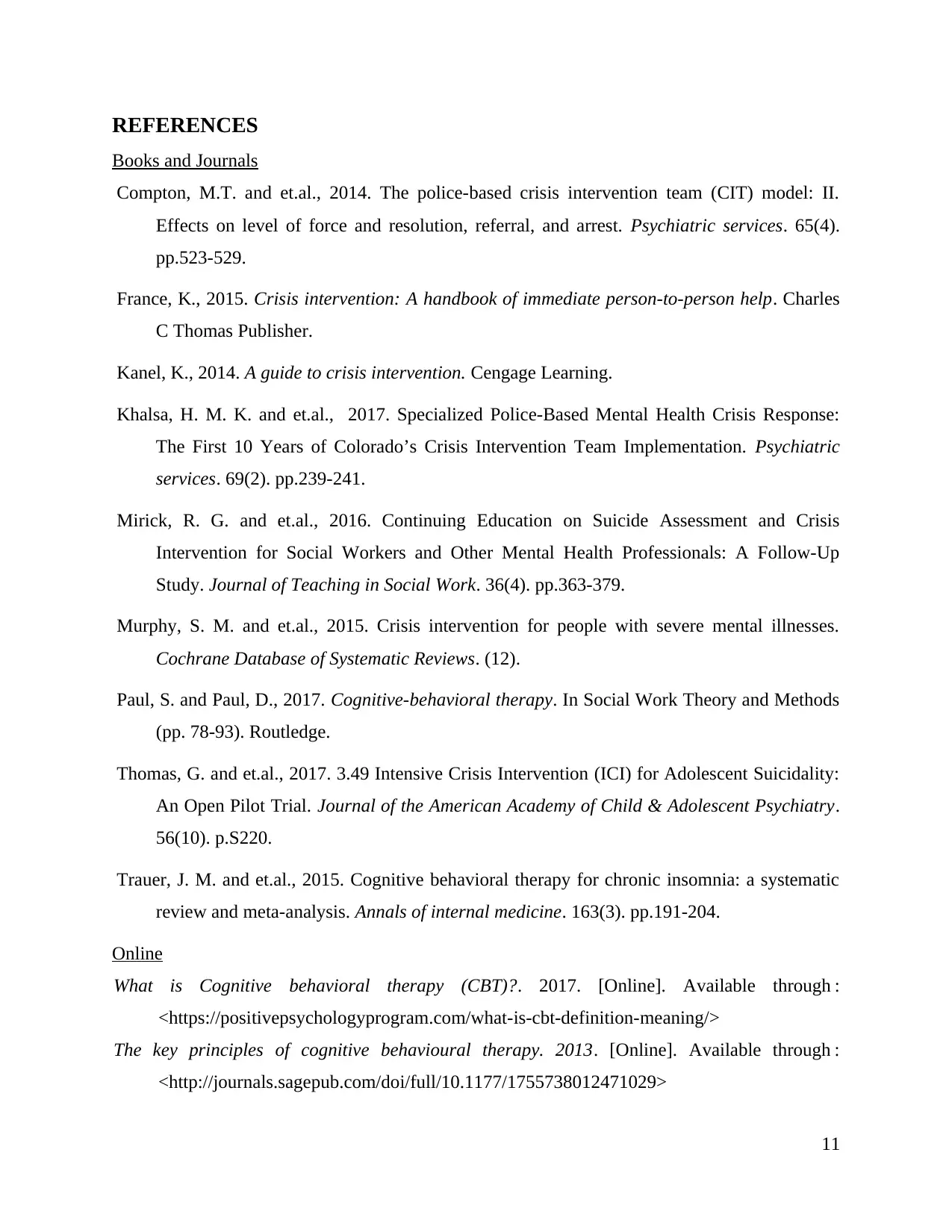
REFERENCES
Books and Journals
Compton, M.T. and et.al., 2014. The police-based crisis intervention team (CIT) model: II.
Effects on level of force and resolution, referral, and arrest. Psychiatric services. 65(4).
pp.523-529.
France, K., 2015. Crisis intervention: A handbook of immediate person-to-person help. Charles
C Thomas Publisher.
Kanel, K., 2014. A guide to crisis intervention. Cengage Learning.
Khalsa, H. M. K. and et.al., 2017. Specialized Police-Based Mental Health Crisis Response:
The First 10 Years of Colorado’s Crisis Intervention Team Implementation. Psychiatric
services. 69(2). pp.239-241.
Mirick, R. G. and et.al., 2016. Continuing Education on Suicide Assessment and Crisis
Intervention for Social Workers and Other Mental Health Professionals: A Follow-Up
Study. Journal of Teaching in Social Work. 36(4). pp.363-379.
Murphy, S. M. and et.al., 2015. Crisis intervention for people with severe mental illnesses.
Cochrane Database of Systematic Reviews. (12).
Paul, S. and Paul, D., 2017. Cognitive-behavioral therapy. In Social Work Theory and Methods
(pp. 78-93). Routledge.
Thomas, G. and et.al., 2017. 3.49 Intensive Crisis Intervention (ICI) for Adolescent Suicidality:
An Open Pilot Trial. Journal of the American Academy of Child & Adolescent Psychiatry.
56(10). p.S220.
Trauer, J. M. and et.al., 2015. Cognitive behavioral therapy for chronic insomnia: a systematic
review and meta-analysis. Annals of internal medicine. 163(3). pp.191-204.
Online
What is Cognitive behavioral therapy (CBT)?. 2017. [Online]. Available through :
<https://positivepsychologyprogram.com/what-is-cbt-definition-meaning/>
The key principles of cognitive behavioural therapy. 2013. [Online]. Available through :
<http://journals.sagepub.com/doi/full/10.1177/1755738012471029>
11
Books and Journals
Compton, M.T. and et.al., 2014. The police-based crisis intervention team (CIT) model: II.
Effects on level of force and resolution, referral, and arrest. Psychiatric services. 65(4).
pp.523-529.
France, K., 2015. Crisis intervention: A handbook of immediate person-to-person help. Charles
C Thomas Publisher.
Kanel, K., 2014. A guide to crisis intervention. Cengage Learning.
Khalsa, H. M. K. and et.al., 2017. Specialized Police-Based Mental Health Crisis Response:
The First 10 Years of Colorado’s Crisis Intervention Team Implementation. Psychiatric
services. 69(2). pp.239-241.
Mirick, R. G. and et.al., 2016. Continuing Education on Suicide Assessment and Crisis
Intervention for Social Workers and Other Mental Health Professionals: A Follow-Up
Study. Journal of Teaching in Social Work. 36(4). pp.363-379.
Murphy, S. M. and et.al., 2015. Crisis intervention for people with severe mental illnesses.
Cochrane Database of Systematic Reviews. (12).
Paul, S. and Paul, D., 2017. Cognitive-behavioral therapy. In Social Work Theory and Methods
(pp. 78-93). Routledge.
Thomas, G. and et.al., 2017. 3.49 Intensive Crisis Intervention (ICI) for Adolescent Suicidality:
An Open Pilot Trial. Journal of the American Academy of Child & Adolescent Psychiatry.
56(10). p.S220.
Trauer, J. M. and et.al., 2015. Cognitive behavioral therapy for chronic insomnia: a systematic
review and meta-analysis. Annals of internal medicine. 163(3). pp.191-204.
Online
What is Cognitive behavioral therapy (CBT)?. 2017. [Online]. Available through :
<https://positivepsychologyprogram.com/what-is-cbt-definition-meaning/>
The key principles of cognitive behavioural therapy. 2013. [Online]. Available through :
<http://journals.sagepub.com/doi/full/10.1177/1755738012471029>
11
Paraphrase This Document
Need a fresh take? Get an instant paraphrase of this document with our AI Paraphraser
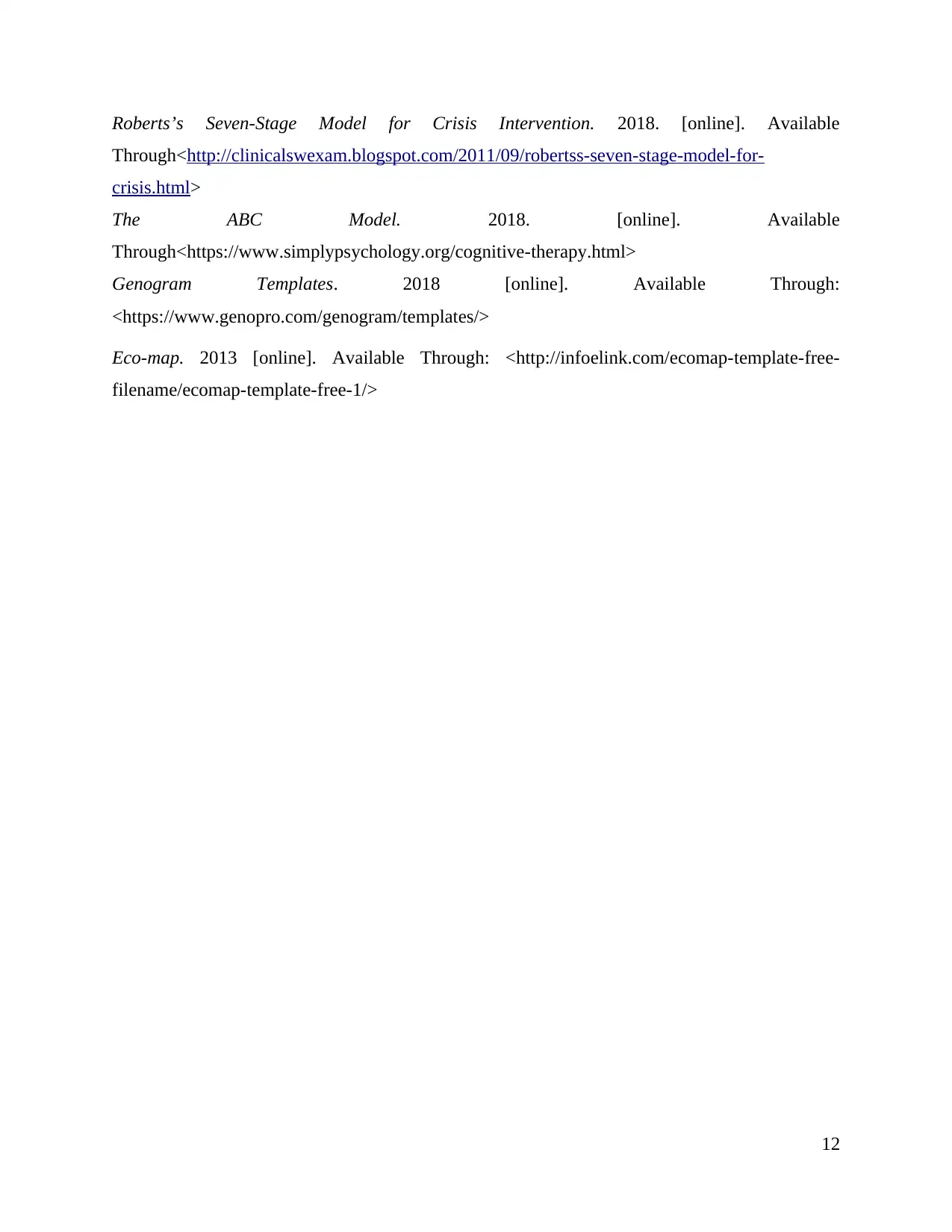
Roberts’s Seven-Stage Model for Crisis Intervention. 2018. [online]. Available
Through<http://clinicalswexam.blogspot.com/2011/09/robertss-seven-stage-model-for-
crisis.html>
The ABC Model. 2018. [online]. Available
Through<https://www.simplypsychology.org/cognitive-therapy.html>
Genogram Templates. 2018 [online]. Available Through:
<https://www.genopro.com/genogram/templates/>
Eco-map. 2013 [online]. Available Through: <http://infoelink.com/ecomap-template-free-
filename/ecomap-template-free-1/>
12
Through<http://clinicalswexam.blogspot.com/2011/09/robertss-seven-stage-model-for-
crisis.html>
The ABC Model. 2018. [online]. Available
Through<https://www.simplypsychology.org/cognitive-therapy.html>
Genogram Templates. 2018 [online]. Available Through:
<https://www.genopro.com/genogram/templates/>
Eco-map. 2013 [online]. Available Through: <http://infoelink.com/ecomap-template-free-
filename/ecomap-template-free-1/>
12

13
1 out of 15
Your All-in-One AI-Powered Toolkit for Academic Success.
+13062052269
info@desklib.com
Available 24*7 on WhatsApp / Email
![[object Object]](/_next/static/media/star-bottom.7253800d.svg)
Unlock your academic potential
© 2024 | Zucol Services PVT LTD | All rights reserved.
